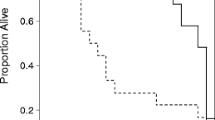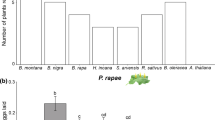Abstract
For some phytophagous insects, egg maturation may be dependent on adult feeding. Accordingly, rates of egg maturation may be dependent on the quality and quantity of available food sources. In turn, oviposition behavior could be affected by diet quality via changes in egg load (number of mature eggs carried by a female). Experiments were conducted to determine whether adult feeding may affect oviposition behavior of the glassy-winged sharpshooter, Homalodisca vitripennis. No-choice tests demonstrated that eggs accumulated in glassy-winged sharpshooter abdomens as time since last oviposition increased largely as a function of feeding plant species. In choice tests, glassy-winged sharpshooter females were observed most frequently on the plant species that imparted the greatest egg maturation rate in no-choice tests. Direct tests of the effects of egg load on glassy-winged sharpshooter oviposition behavior found that females were more likely to deposit eggs as egg load increased. Similarly, acceptance of a low-ranked oviposition plant species by female glassy-winged sharpshooters increased with egg load and time since last oviposition. The results indicate that adult feeding affected glassy-winged sharpshooter egg maturation, plant species varied in quality for providing nutrients for egg maturation, and egg load affected oviposition behavior. Thus, the quantity and quality of available feeding plant species may affect glassy-winged sharpshooter egg maturation rates, which in turn may affect the plant species female glassy-winged sharpshooters select for oviposition.




Similar content being viewed by others
References
Agnew K, Singer MC (2000) Does fecundity drive the evolution of insect diet? Oikos 88:533–538
Aluja M, Diaz-Fleischer F, Papaj DR, Lagunes G, Sivinski J (2001) Effects of age, diet, female density, and the host resource on egg load in Anastrepha ludens and Anastrepha oblique (Diptera: Tephritidae). J Insect Physiol 47:975–988
Boggs CL (1997) Reproductive allocation from reserves and income in butterfly species with differing adult diets. Ecology 78:181–191
Boggs CL (2009) Understanding insect life histories and senescence through a resource allocation lens. Funct Ecol 23:27–37
Brodbeck BV, Mizell RF, French WJ, Andersen PC, Aldrich JH (1990) Amino acids as determinants of host preference for the xylem feeding leafhopper, Homalodisca coagulata (Homoptera: Cicadellidae). Oecologia 83:338–345
Brodbeck BV, Mizell RF, Andersen PC (1993) Physiological and behavioral adaptations of three species of leafhoppers in response to the dilute nutrient content of xylem fluid. J Insect Physiol 39:73–81
Brodbeck BV, Andersen PC, Oden S, Mizell RF (2007) Preference-performance linkage of the xylem feeding leafhopper, Homalodisca vitripennis (Hemiptera: Cicadellidae). Environ Entomol 36:1512–1522
Brodbeck BV, Andersen PC, Mizell RF (2011) Nutrient mediation of behavioral plasticity and resource allocation in a xylem-feeding leafhopper. Oecologia 165:111–122
Courtney SP, Chen GK, Gardner A (1989) A general model for individual host selection. Oikos 55:55–65
Harris MO, Miller JR (1988) Host-acceptance behavior in an herbivore fly, Delia antique. J Insect Physiol 34:179–190
Hoddle MS, Triapitsyn SV, Morgan DJW (2003) Distribution and plant association records for Homalodisca coagulata (Hemiptera: Cicadellidae) in Florida. Fla Entomol 86:89–91
Hopkins RJ, Ekbom B (1996) Low oviposition stimuli reduce egg production in the pollen beetle Meligethes aeneus. Physiol Entomol 21:118–122
Horton DR, Krysan JL (1991) Host acceptance behavior of pear psylla (Homoptera: Psyllidae) affected by plant species, host deprivation, habituation, and eggload. Ann Entomol Soc Am 84:612–627
Jallow MFA, Zalucki MP (1998) Effects of egg load on host-selection behavior of Helicoverpa amigera (Hübner)(Lepidoptera: Noctuidae). Aust J Zool 46:291–299
Javoiš J, Tammaru T (2006) The effect of egg load on readiness to accept a low-quality host plant is weak and age dependent in a geometrid moth. Ecol Entomol 31:597–600
Jervis MA, Copland MJW (1996) The life cycle. In: Jervis M, Kidd N (eds) Insect natural enemies: practical approaches to their study and evaluation. Chapman and Hall, New York, pp 63–457
Jervis MA, Boggs CL, Ferns PN (2005) Egg maturation strategy and its associated trade-offs: a synthesis focusing on Lepidoptera. Ecol Entomol 30:35–375
Krugner R (2010) Differential reproductive maturity between geographically separated populations of Homalodisca vitiripennis (Germar) in California. Crop Prot 29:1521–1528
Lauzière I, Sétamou M (2009) Suitability of different host plants for oviposition and development of Homalodisca vitripennis (Hemiptera: Cicadellidae) and its implications on mass rearing. Ann Entomol Soc Am 102:642–649
Minkenberg OPJM, Tatar M, Rosenheim JA (1992) Egg load as a major source of variability in insect foraging and oviposition behavior. Oikos 65:134–142
Mizell RF, Tipping C, Andersen PC, Brodbeck BV, Hunter WB, Northfield T (2008) Behavioral model for Homalodisca vitripennis (Hemiptera: Cicadellidae): optimization of host plant utilization and management implications. Environ Entomol 37:1049–1062
Monks A, Kelly D (2003) Motivation models fail to explain oviposition behaviour in the diamondback moth. Physiol Entomol 28:199–208
Murphy DD (1983) Nectar sources as constraints on the distribution of egg masses by the checkerspot butterfly, Euphydryas chalcedona (Lepidoptera: Nymphalidae). Environ Entomol 12:463–466
Murphy DD, Menninger MS, Ehrlich PR (1984) Nectar source distribution as a determinant of oviposition host species in Euphydryas chalcedona. Oecologia 62:269–271
Papaj DR (2000) Ovarian dynamics and host use. Annu Rev Entomol 45:423–448
Prokopy RJ, Roitberg BD, Vargas RI (1994) Effects of egg load on finding and acceptance of host fruit in Ceratitis capitata flies. Physiol Entomol 19:124–132
SAS Institute (2001) JMP statistics and graphics guide. SAS Institute, Cary NC
Scheirs J, De Bruyn L (2002) Integrating optimal foraging and optimal oviposition theory in plant-insect research. Oikos 96:187–191
Scheirs J, De Bruyn L, Verhagen R (2000) Optimization of adult performance determines host choice in a grass miner. Proc R Soc Lond B Bio 267:2065–2069
Sisterson MS (2008) Egg load dynamics of Homalodisca vitripennis. Environ Entomol 37:1200–1207
Sisterson MS, Averill AL (2002) Costs and benefits of food foraging for a Braconid parasitoid. J Insect Behav 15:571–588
van Randen EJ, Roitberg BD (1996) The effect of egg load on superparasitism by the snowberry fly. Entomol Exp Appl 79:241–245
Wäckers FL, Romeis J, van Rijn P (2007) Nectar and pollen feeding by insect herbivores and implications for multitrophic interactions. Annu Rev Entomol 52:301–323
Wheeler D (1996) The role of nourishment in oogenesis. Annu Rev Entomol 41:407–431
Acknowledgments
I thank Donal Dwyer, Emily Felts, and Sean Uchima for technical assistance; Rodrigo Krugner, Jay Rosenheim, and Drake Stenger for helpful comments on the manuscript. Mention of trade names or commercial products in this publication is solely for the purpose of providing specific information and does not imply recommendation or endorsement by the U.S. Department of Agriculture. This article is in the public domain and not copyrightable. It may be freely reprinted with customary crediting of source. USDA is an equal opportunity provider and employer.
Author information
Authors and Affiliations
Corresponding author
Additional information
Handling Editor: Joseph Dickens.
Rights and permissions
About this article
Cite this article
Sisterson, M.S. Host selection by Homalodisca vitripennis: the interplay between feeding, egg maturation, egg load, and oviposition. Arthropod-Plant Interactions 6, 351–360 (2012). https://doi.org/10.1007/s11829-012-9186-3
Received:
Accepted:
Published:
Issue Date:
DOI: https://doi.org/10.1007/s11829-012-9186-3




